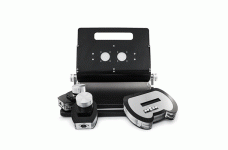Light Discrimination Apparatus
The Light Discrimination Apparatus illustrates the various psychophysical methods (limits, average error, constant stimuli, etc.) used in visual discrimination. By watching the two 1.375” diameter light stimuli while the examiner adjusts light intensity, the subject’s task is to determine when lights are at an equal intensity or when one light is more or less bright than the other. Each stimulus can be independently varied in intensity by subject or examiner. Light stimuli are presented using high intensity LEDs, which are calibrated to give consistent and highly reliable intensity across its usable range.
FEATURES
- LCD and keypad control
- Adjustable main body for matching subjects’ viewing angle relative to their height and viewing comfort
- USB port for serial communication (when available, the software will be supplied at no charge)
- Easy-to-read LCD display
- Allows for time and accuracy measurements
- LUX measurement on final adjustment (independent window measurement) for meaningful data generation
- Built from high-quality components manufactured in USA, Japan, Germany, Italy
- Ergonomic handle for easy carrying
- Medical Grade power source (short circuit protected through reprogrammable fuse)
- 2 x independent LUX metering ICs
- 256 step LED control (8 bits)
- Smooth (non-noise cued) LED control paddle
- Aluminum, stainless steel, and acrylic body for sturdy usage
- High resistance polymer base, easy to clean
- Black coated electrostatic painting for cue less distraction, high durability and easy maintenance
- Acrylic stimulus windows for high resistance and safety
APPLICATION
Discrimination of light is a crucial ability in daily life. Even more light discrimination is crucial to artists, photographers, illumination technicians, and movie directors. It is also a critical ability among pilots, air traffic controllers and firefighters, among others. The subject’s task is to evaluate two stimulus lights (calibrated) to either judge if they are matched or different. The system provides a LUX measurement of each presented light which allows the evaluator or researcher to obtain a good measure of light discrimination accuracy. The Light Discrimination Apparatus is also a great tool for demonstrations in the classroom or experimental lab. Recommended for demonstrations in psychology (sensory and perception), physiology and courses in related areas.
PROCEDURE
Subject should be sitting in a comfortable chair in front of the device. The adjustable body of the device will be set so that the subject has a direct line-of-sight to the stimuli. The room should be darkened or dimmed for better results with the lowest possible level of environmental noise and distractions (also pink or white noise can be helpful for this endeavor). Subject will be required to perform two different tasks. The first one is to match the experimenter’s selection of first window (left) with a similar light level in the second window (right) using the smooth cue-less rotary paddle control. Discrimination ability will be judged among several trials by recording the experimenter’s selected LUX for first stimulus, then the subject’s judged LUX level and the difference between both. Second task is to judge whether the two light stimulus windows match. Results can be recorded in the provided forms.
- Line Voltage: 105/125V AC 50/60 Hz - 220V AC 50/60Hz
- Stimulus Lamp:
- 2 x Warm light High intensity LEDs
- 3500K CCT (3220K - 3710K)
- CRI: Minimum 80 (x2)
- Typical 85 (x2)
- Flux 67 - 80
- 160 - 120 degrees of viewing angle
- Instruction manual available in English and Spanish





